Spring houseplant care is super important! This is the time of year when most indoor plants come out dormancy, and it’s also the beginning of their active growing season.
It can be a difficult change for some. So use this detailed checklist to help make the seasonal transition easier for your houseplants in the spring.
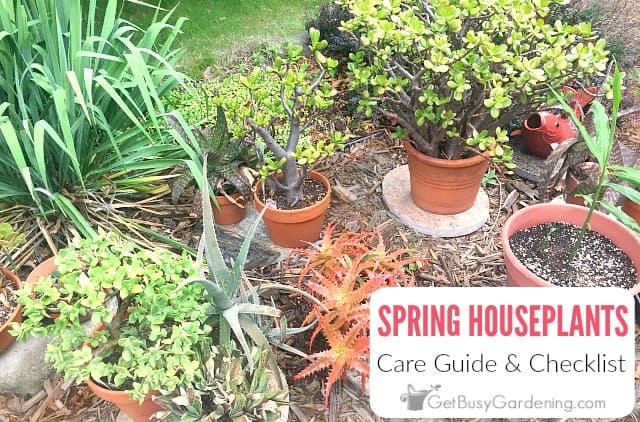
Spring one of the most important times of the year for growing indoor plants. Longer days and warmer temperatures signal the end of dormancy, and the beginning of new growth.
It’s important to help ease the stress of this seasonal change for them. Giving them some extra TLC in the spring will get them through it without any problems.
That’s where my spring houseplant care checklist comes in handy. Use this detailed list to ensure you’re giving your indoor plants the care they need to get their growing season off to a great start!
Spring Houseplant Care Checklist & Tips
Since they are waking up from their long winter rest, houseplants have different needs in the spring. Use this checklist to adjust your care routine for them during this crucial time.
1. Clean the leaves
It’s time for spring cleaning, and your houseplants are no exception. Dust settles on their leaves just like it does on your furniture.
Cleaning the leaves helps them look better and stay healthier. To clean indoor plants in spring, you can bring them outside and rinse the leaves with a gentle spray from the garden hose.
Instead of bringing them outside, you can rinse them in the sink or shower with tepid water. Or you can clean the leaves by gently wiping them with a damp cloth.
Don’t use any type of leaf polishes or waxes on them though. Those types of products can clog the pores, and harm sensitive houseplants.
Instead, you can use a diluted mild liquid soap to wash the leaves if you want to (be sure to test it on a few leaves before washing the whole plant).
2. Repot houseplants that need it
Spring is the best time for repotting houseplants. Repotting will stimulate fresh new growth, and give them plenty of room to expand.
But don’t just automatically repot all of your houseplants in spring, only the ones that need it. Some hate to be repotted, and can have a difficult time recovering from the shock.
If any of your houseplants have obviously outgrown their container, then you should definitely put them into a larger one to give them a fresh start for spring.
Some of the most common signs that your houseplant has outgrown the pot are…
- Roots growing out of the bottom of the pot, or over the top of the soil
- The pot looks like it’s about to burst
- Water runs right through the soil without soaking in
- The roots are growing in a circular pattern inside the pot
Learn more about the signs to look for, and get step-by-step instructions for how to repot indoor plants here.
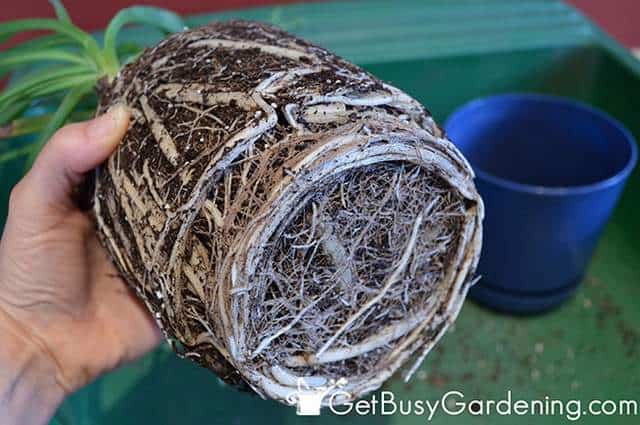
3. Slowly acclimate them to being outside
Many indoor plants benefit from being outside during the summer. But you shouldn’t just abruptly move them out there. It’s best to slowly acclimate them to living outdoors.
Believe it or not, houseplants can get sunburned, just like humans can. They’re also used to living a cushy, pampered life indoors where there’s no wind, heavy rain, or wildly fluctuating temperatures.
So, to avoid major damage to your houseplants in spring, move them into the sun and rain slowly over a few weeks.
And don’t leave them out overnight until the nighttime temperatures are consistently above 50F.
To make this easy, start by putting them in a protected full shade location for several days.
Then move them to spot where they will get morning or afternoon sun only. Leave them there for a week or so before moving them to a sunnier location.
Check on them every day. If you notice any brown, white, or transparent leaves, then they are getting too much sun. In that case, move them back into the shade for several more days.
Oh, and never put them outside unless the pots have drainage holes. Without drainage holes, your houseplants will drown.
Related Post: The Best Indoor Houseplant Supplies, Tools & Equipment
4. Water more frequently
Since your houseplants are waking up in spring, it’s time to start watering them more frequently. This will help to give them a healthy transition into the growing season.
For most indoor plants, it’s best to keep the soil evenly moist during the spring and summer months. So start checking the soil weekly in the spring, and water them when it starts to feel dry.
Never automatically water on a set schedule though. Always check the soil first by sticking your finger one inch deep. If it feels wet, then don’t give it more water.
If you struggle with this, then use an inexpensive soil moisture gauge to help you get it right every time. Learn more about how to water indoor plants here.
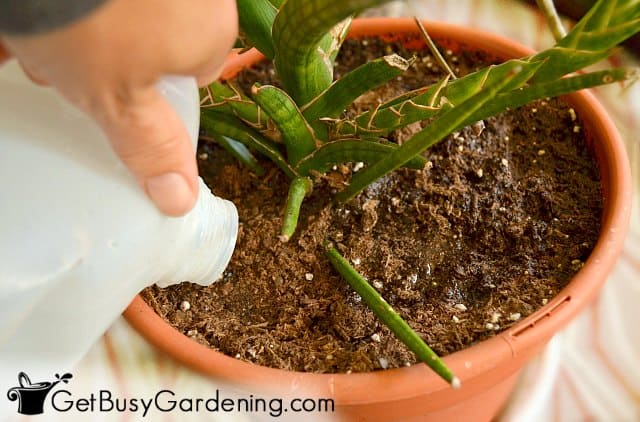
5. Start fertilizing again
Since spring is the beginning of their active growing season, it’s a great time to start fertilizing your houseplants again.
Remember that they are just waking up from their winter dormancy. So it’s a good idea to start feeding them slowly, rather than giving them a full strength dose right off the bat. Otherwise it could be too much of a shock for them.
If you use a liquid fertilizer, start with a 1/4 or 1/2 dose, and slowly increase it to full strength by summer. I also recommend using organic products rather than synthetic chemical ones.
Those harsh chemical fertilizers can burn sensitive plants, which is a bigger concern when they are coming out of dormancy in the spring.
A general purpose organic liquid works great for most houseplants, or you can use an organic compost tea. If you prefer, you can add slow release granules to the soil instead of using a liquid.

6. Prune any weak or leggy growth
Over the winter, some of your houseplants may have become weak or leggy looking. Spring is the best time to trim houseplants to remove any unhealthy branches or leaves, and clean them up.
Pruning houseplants in spring encourages branching and fresh new growth. Cut off any dead or dying leaves and branches, and prune off brown leaf tips and edges.
You can also cut any dead flower spikes down to the base of the plant, or pinch out any scraggly looking branch tips. Either a precision pruner or bonsai shears work great for pruning houseplants.
7. Capture rainwater for your houseplants
Rainwater is the best type of water to use on houseplants, and it’s free! Set up your rain barrel as early as possible, so you can start collecting those spring showers for your indoor plants.
If you don’t already own one, I highly recommend getting a rain barrel. Once you start using rainwater on your houseplants rather than tap water, you will notice an improvement in their health and vigor.
8. Give your houseplants some air
On warm spring days, open the windows near your indoor plants to give them some fresh air and humidity. This is another great way to start acclimating them to living outside for the summer.
But even if you don’t plan to move them out, your houseplants will still benefit from fresh air, and all that yummy humidity that comes in through the open windows.
9. Move them out of that sunny window
Spring means longer days, and more intense sunlight (woohoo!). But that increased sunlight can burn sensitive indoor plants that are sitting in a south facing window.
That’s right, they can get sunburn right thorough the glass! In fact, that sunny window can create a greenhouse effect for them, which is way too hot for some.
So, if you moved any sensitive houseplants onto the sunny window ledge for the winter, then you should move them in the spring before the sun becomes even more intense over the next few months.
At minimum, you should keep an eye on them. If you notice any of the leaves are turning white, brown, or transparent, then that means they’re getting too much sun. So, move them a little further away from the window.
Related Post: How To Clean Up A Garden In Spring (With Cleaning Checklist)
FAQs About Spring Houseplant Care
Below I will answer some of the most frequently asked questions about spring houseplant care. If you can’t find the answer to your question here, then ask it in the comments below. I will get it answered as soon as I can.
When should I start fertilizing my indoor plants in the spring?
Begin by giving your houseplants a weak dose of fertilizer in early spring (March/April). Then gradually increase the dose so that it’s full strength by June.
Can I move my houseplants outside in the spring?
Yes, but be very careful that you do it slowly. Remember, they are used to living in a temperature controlled, calm, low-light environment. Moving them outside into the direct sun right away can cause major damage, and burn their leaves. Heavy wind and rain can also cause major damage.
Giving your houseplants a little extra TLC in the spring keeps them looking their best, and helps to gently bring them out of dormancy. So kick off their active growing season right by following the tips in this spring houseplant care checklist.
If you want to learn all there is to know about maintaining healthy indoor plants, then you need my Houseplant Care eBook. It will show you everything you need to know about how to keep every plant in your home thriving. Download your copy now!
More Houseplant Care Guides
- How To Keep Indoor Plants Alive In Winter
- Fall Houseplant Care Guide
- Houseplants Don’t Like Drafts
- How To Repot A Snake Plant
What spring houseplant care tips would you add to this list? Tell us in the comments below.
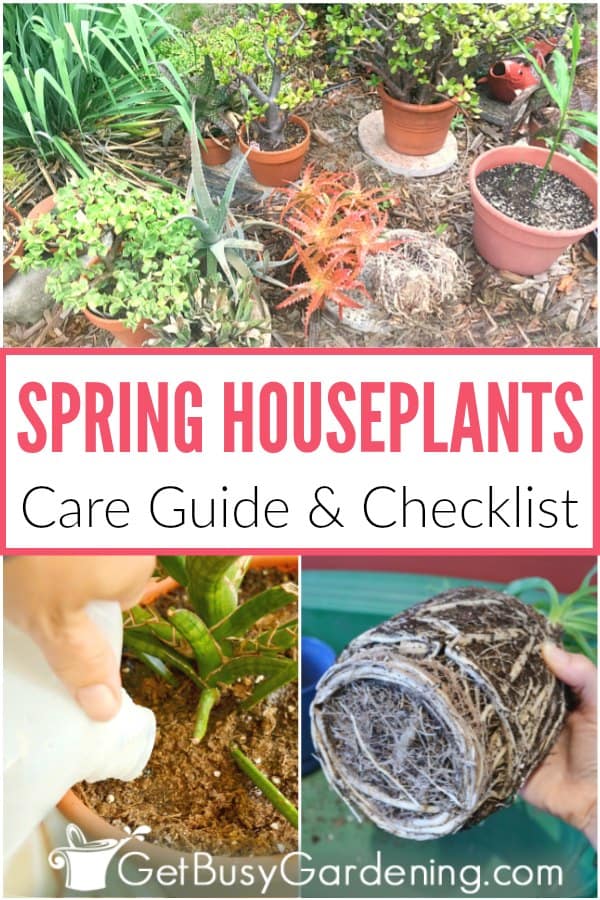
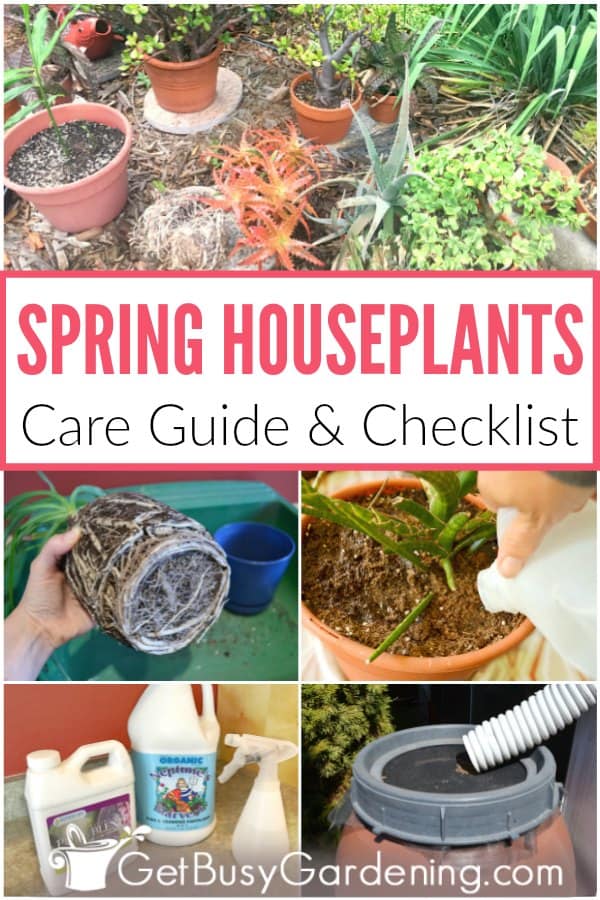


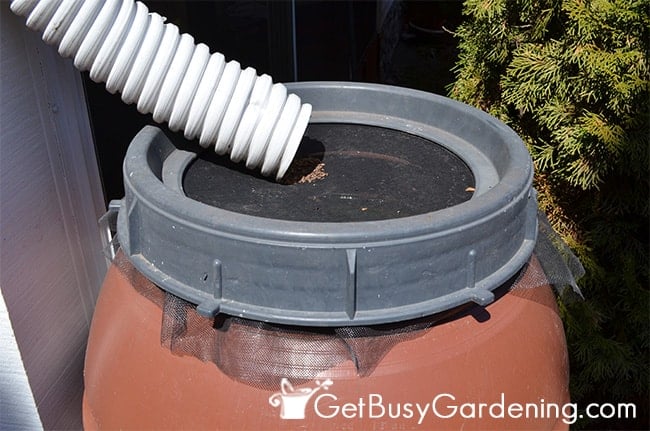


Trish says
I’ve had my philandandron for 3 years and it’s been growing great until this March. It has brownest spot and yellowest spots. I’ve cleaned the leaves and don’t see any bugs. I hate to loose it but is really looking sad. I also trimmed it up
Amy Andrychowicz says
Brown spots on the leaves could be from sunburn. Did you move your houseplant into the sun this spring perhaps? Yellow leaves usually mean a plant is either over or under watered. Houseplants need to be watered more often in the spring and summer than they do during the winter. So perhaps you need to start watering more often?
evan says
Thank you lots of helpful tips for caring for my houseplants in the spring. i did not know 🙂
Amy Andrychowicz says
You’re welcome!